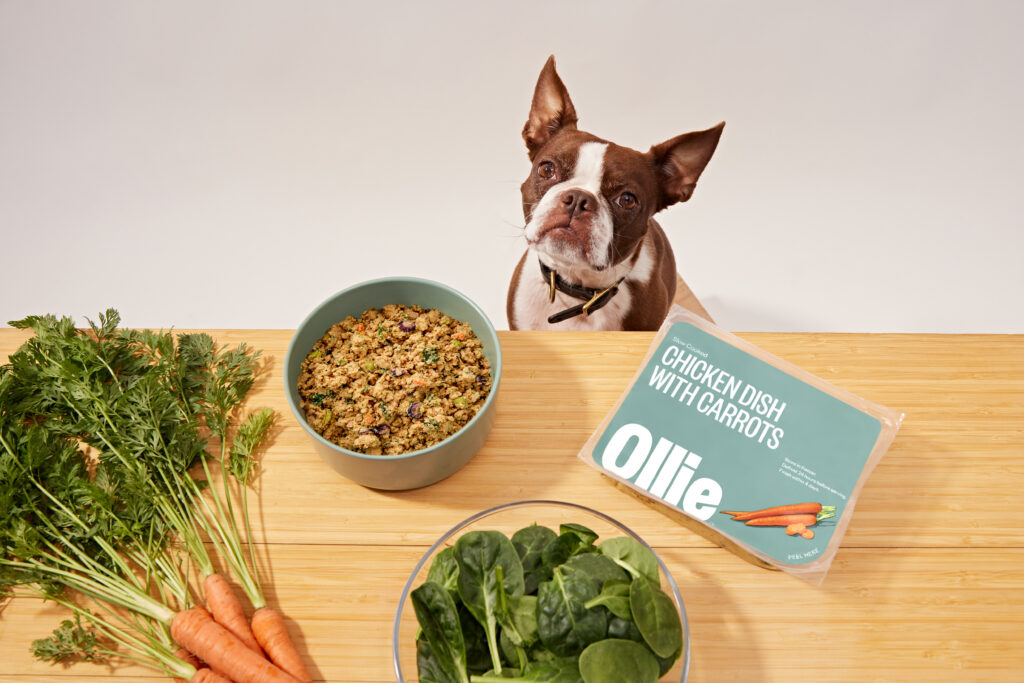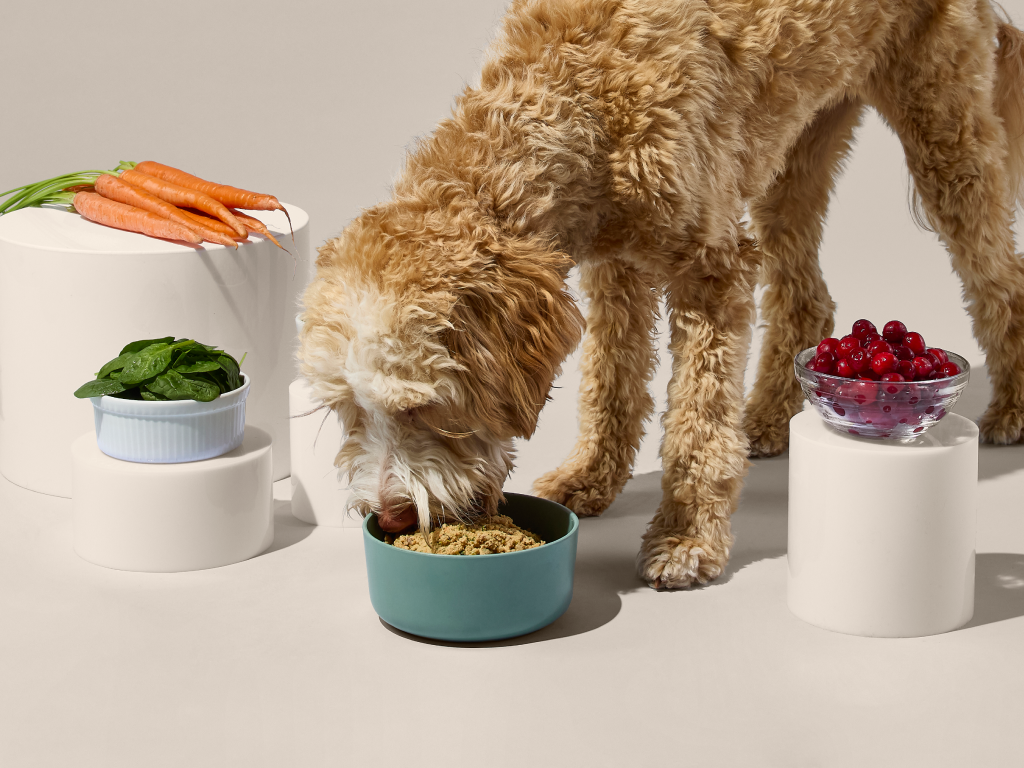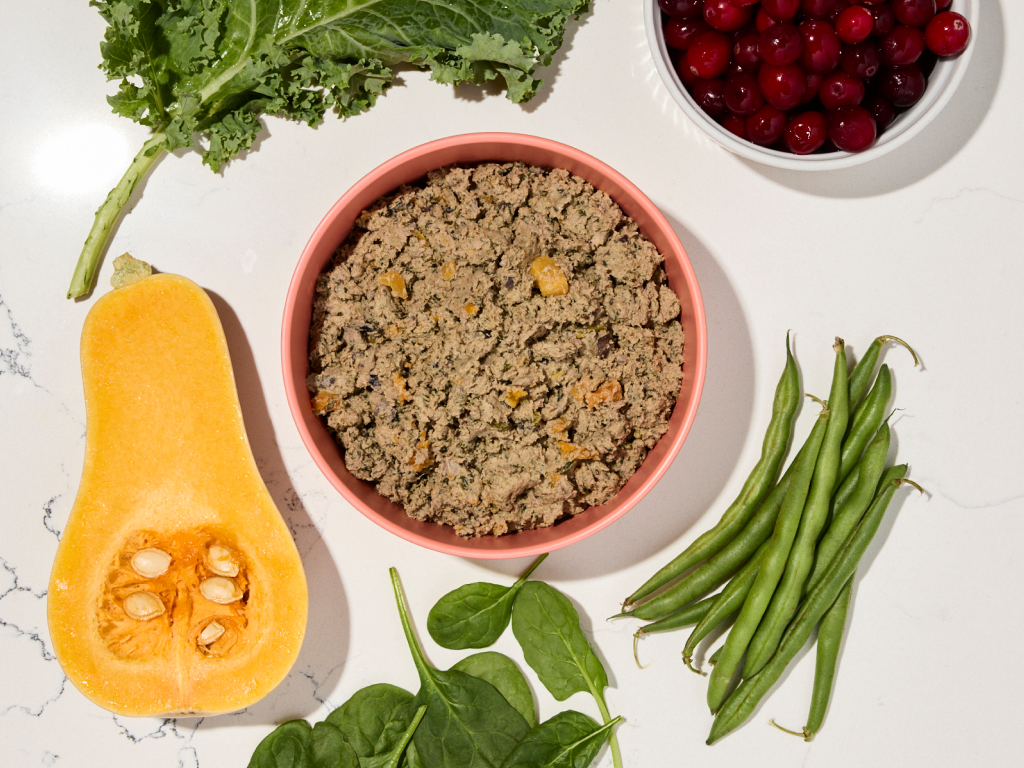Hey Ollie blog readers! We’re offering you an exclusive 60% OFF your starter box! Try now!
If your dog is constantly scratching, dealing with digestion issues, or showing signs of discomfort after meals, you might be wondering if their food is the culprit. According to Banfield Pet Hospital data, food allergies affect just 0.2 percent of dogs [1], but for those affected, limited ingredient diets can provide crucial relief. This comprehensive guide explores when limited ingredient dog food might benefit your pup and what pup parents need to know before making the switch.
What Makes Limited Ingredient Dog Food Different?
Limited ingredient dog foods are specially formulated with a reduced number of ingredients to minimize potential allergens and sensitivities. These diets typically contain:
- Single protein source: Often featuring novel proteins like duck, lamb, or kangaroo that your dog hasn’t been exposed to previously
- Single carbohydrate: Common options include sweet potato, brown rice, or peas
- Minimal additives: Fewer preservatives, colors, and unnecessary ingredients
However, it’s important to note that not all products marketed as “limited ingredient” are created equal. Some kibble brands simply contain fewer additives than traditional formulas while still including multiple protein sources.
Who Needs Limited Ingredient Dog Food?
Dogs with Food Allergies
The most frequently reported food allergens involved in cutaneous adverse food reactions in dogs were beef (102 dogs, 34%), dairy products (51 dogs, 17%), chicken (45 dogs, 15%), wheat (38 dogs, 13%) and lamb (14, 5%) [2]. For dogs with veterinarian-confirmed food allergies, limited ingredient diets serve as a cornerstone of long-term management.
Common signs of food allergies include:
- Chronic skin irritation and itching
- Recurring ear infections
- Digestive issues like vomiting or diarrhea
- Hot spots or excessive licking
The best and most accurate method of diagnosing a food allergy is to feed a hypoallergenic diet for 8 to 12 weeks as a food trial, called an elimination trial [3]. This process requires veterinary supervision and strict adherence to avoid any previous ingredients.
Dogs with Sensitive Stomachs
Unlike food allergies, food sensitivities don’t involve the immune system but occur when the digestive system struggles to process certain ingredients. These human grade foods tend to fare better in dogs with sensitive stomachs. This is because they are often less processed than feed grade alternatives, which require rendering (a process that uses extreme heat) to kill any microbes and make the food safe to eat [4].
Symptoms of food sensitivities:
- Regurgitation
- Vomiting
- Bloating
- Inconsistent stools
- Excessive gas
For dogs with sensitive stomachs, limited ingredient diets can provide relief as long as they don’t contain the triggering ingredients.
Potential Risks and Considerations
Risk of Nutritional Deficiencies
Limited ingredient diets aren’t automatically healthier than traditional formulas. As veterinary experts warn, restricting your dog’s diet without medical necessity can lead to nutritional imbalances over time. The key is ensuring any limited ingredient food you choose meets AAFCO Dog Food Nutrient Profiles [5] for complete and balanced nutrition.
Connection to Dilated Cardiomyopathy (DCM)
In 2018, the FDA began investigating reports of canine dilated cardiomyopathy linked to certain grain-free diets, many of which fall into the limited ingredient category. These foods often contained high proportions of peas, lentils, and potatoes as main ingredients. While the investigation is ongoing, it highlights the importance of consulting your veterinarian before switching to any specialty diet.
Cross-Contamination Concerns
Unlike veterinary diets, retail pet foods are not manufactured with the extreme health and safety protocols to prevent cross-contamination [3]. This means that limited ingredient foods from pet stores may still contain trace amounts of allergens despite their labeling.

Healthy Dog Food Alternatives to Consider
Human-Grade Dog Food Benefits
Purported benefits of human-grade pet foods include reduced inflammation, enhanced coat quality, and improved gut health [6]. Human-grade dog food will not have any feed quality rendered meat meals; only fresh, high-quality food that provides loads of nutrients, antioxidants, vitamins, and minerals [7].
Key advantages of human-grade alternatives:
- Higher quality protein sources
- Better digestibility
- Fewer artificial additives and preservatives
- Essential fatty acids specifically are the powerhouses when it comes to a healthy coat. Omega-3 and omega-6 fatty acids… Without these fatty acids, you may notice signs of deficiency in your pet, like dry, flaky skin, a dull coat, dermatitis, or even hair loss [4]
Fresh Dog Food Options
Fresh, minimally processed dog food offers several benefits over traditional kibble:
- Preserved nutritional integrity through gentle cooking methods
- Single animal protein sources suitable for dogs with allergies
- No artificial colors, flavors, or preservatives
- Better palatability for picky eaters

Healthy Food for New Puppies
AAFCO requires dog foods formulated for “Growth and reproduction” or “All life stages” to specify whether they include or exclude growth of large-breed dogs… AAFCO defines a large breed puppy as any dog whose adult weight is expected to exceed 70 pounds [8].
When selecting food for new puppies:
- Choose formulas labeled for “Growth and reproduction” or “All life stages”
- For large breed puppies, ensure calcium levels are appropriate to prevent developmental orthopedic disease
- Dogs over the age of one are considered adults, except for some large and giant breeds who do not fully mature until age two. The Association of American Feed Control Officials recognizes puppies and pregnant or lactating dogs have different nutritional needs from adult dogs [9]
Choosing the Right Approach
When to Consult Your Veterinarian
Before switching to limited ingredient dog food, consult your veterinarian if your pup experiences:
- Persistent skin issues or allergic reactions
- Chronic digestive problems
- Recurring ear infections
- Sudden changes in appetite or behavior
What to Look For
When evaluating limited ingredient options:
- AAFCO compliance: Ensure the food meets nutritional adequacy standards
- Single, novel protein: Look for proteins your dog hasn’t eaten before
- Quality manufacturing: Choose brands with transparent sourcing and manufacturing practices
- Veterinary formulation: Opt for foods developed with veterinary nutritionists

The Ollie Advantage
At Ollie, our fresh, human-grade recipes are carefully formulated with veterinary nutritionists using single animal protein sources, making them suitable options for dogs with food sensitivities.
Our recipes feature:
- High-quality proteins including chicken, beef, turkey, pork, and lamb
- Human-grade fruits and vegetables
- Essential nutrients like omega fatty acids for healthy skin and coat
- No artificial additives or low-quality fillers
Each meal is gently cooked to preserve nutritional integrity and delivered fresh to your door, providing the convenience and quality your pup deserves.
Frequently Asked Questions
Q: How long does it take to see results from limited ingredient dog food? A: Most dogs show improvement within 8-12 weeks if food allergies were the underlying issue. However, some dogs may see changes in digestive symptoms within days.
Q: Can puppies eat limited ingredient dog food? A: Yes, but ensure the formula is labeled for “Growth and reproduction” or “All life stages” and meets AAFCO nutritional standards for puppies.
Q: Are grain-free and limited ingredient diets the same thing? A: No, while some overlap exists, grain-free diets simply exclude grains, while limited ingredient diets minimize the total number of ingredients regardless of grain content.
Q: Is limited ingredient dog food more expensive? A: Generally yes, due to specialized formulation and often higher-quality ingredients. However, the investment may be worthwhile for dogs with confirmed allergies or sensitivities.
Q: Can I make limited ingredient dog food at home? A: While possible, homemade diets require careful planning with a veterinary nutritionist to ensure nutritional completeness and balance.
Ready to explore personalized nutrition options for your pup? Take our quick quiz to discover which Ollie recipe might be the perfect fit for your dog’s unique needs and lifestyle.
Citations
[2] https://pmc.ncbi.nlm.nih.gov/articles/PMC4710035
[3] https://vcahospitals.com/know-your-pet/food-allergies-in-dogs
[4] https://thehonestkitchen.com/blogs/pet-wellness/human-grade-dog-food-benefits
[5] https://fda.gov/animal-veterinary/animal-health-literacy/complete-and-balanced-pet-food
[6] https://pmc.ncbi.nlm.nih.gov/articles/PMC9527297
[7] https://dogster.com/dog-nutrition/best-human-grade-dog-foods
[8] https://dogfoodadvisor.com/frequently-asked-questions/aafco-nutrient-profiles
[9] https://purina.com/articles/dog/health/nutrition/aafco-dog-food
Tagged As:

The nutrition your dog needs,
the food they want.

Enjoying our articles? Subscribe our Newsletters and get new articles directly to your inbox
You might also like
29 September 2025
6 MINS READ
How Is Fresh Dog Food Made?
Unlike standard kibble that undergoes high-heat processing, fresh dog food maintains the natural integrity of ingredients while avoiding artificial additives and fillers. But what exactly goes int…
by Ollie Pets
29 September 2025
7 MINS READ
Is Lamb a Good Protein for Sensitive Stomachs?
Lamb provides significant nutritional benefits for dogs, particularly for pups with sensitive stomachs who need a specialized diet. This protein-rich meat offers an excellent alternative for pups …
by Ollie Pets
29 September 2025
7 MINS READ
Top 10 Fresh Ingredients for Your New Puppy’s Bowl
As dog parents, we naturally want to provide our pups with a strong start in life. This means giving them nutrition that is able to support their rapid growth, abundant energy, and developing immu…
by Ollie Pets







